- Offensive Techniques & Strategies

Basketball Court Lines & Markings

| Court Lines | Court Areas | Court Comparisons |
Semantics are a big part of the game
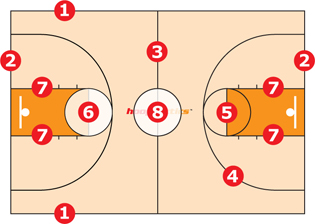
To eliminate confusion, coaches, players and spectators alike must all communicate using the same basic basketball terminology. Here are the court lines & markings found on a typical basketball court:
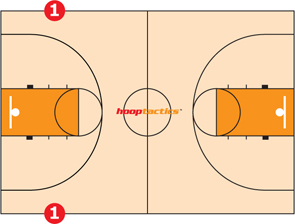
SidelinesThe sidelines are the two boundaries lines running the length of the court. Their location is determined by the width of the court, which is normally 50 feet wide. Along with Baseline and End line they establish the size of the playing area.

Baseline/EndlineThe Baseline/Endline runs from sideline to sideline behind the backboard at the ends of the court. They are located four feet behind the basket, and normally have a width of 50 feet. Baseline and Endline are interchangeable terms depending upon which team has ball position. Baseline is used for the offensive end of the court. Endline is used for the back court or defensive end of the court.
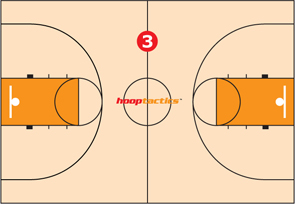
Mid Court LineThe mid court line divides the court in half. Offensively, once the ball crosses the Mid Court Line, it becomes a boundary line reducing the offensive playing area to just half of the court. Also, on most levels, the offensive team only has 8 to 10 seconds to advance the ball across the mid court line.
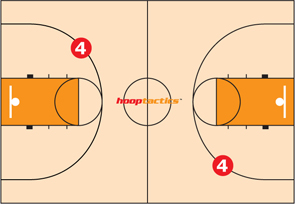
Three Point Line
Field Goals made from outside this Three Point Line or arc count as three points. The distance of the three point line from the basket varies according to the different levels of play.
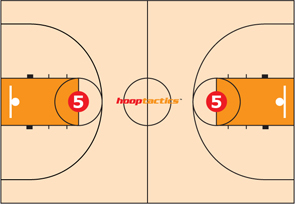
Free Throw Line
This line is used as a boundary line when shooting free throws. It is fifteen feet away from the backboard. On a free throw attempt, the shooter cannot step on or across this line until the ball strikes the rim. The free throw line is also used in defining the three second area.
Free Throw CircleThe free throw circles have a diameter of 12 feet. They come into play on free throws and jump balls. During a free throw attempt, the shooter must remain inside the free throw circle. On jump balls, non-jumpers must remain outside the circle until the ball is tapped by one of the jumpers.
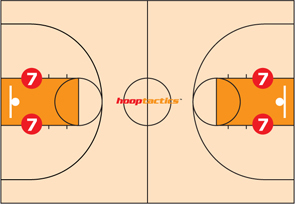
Lane Line
Lane lines are boundaries running from the free throw line to the baseline. The width and shape of the lane lines vary on different levels of the game. The lane lines also contain lane spaces markings used to align and separate the non-shooters. The first lane space, on both sides of the basket, are occupied by the opposing team from the free throw shooter. Non-shooters cannot step into the three second area until the ball leaves the free throw shooter's hand.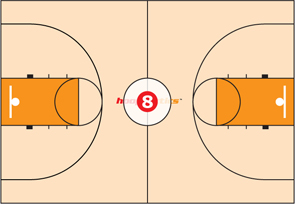
Center CircleThe Center Circle is a 12 foot diameter circle located in the center of the court. It is used to start the game and other jump ball situations. On jump balls, non-jumpers must remain outside the circle until the ball is tapped by one of the jumpers.


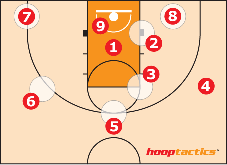
Each area of the court has its own name. It is very important to use the proper terminology when describing these areas. The court areas of a typical basketball court include:
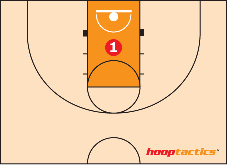
Three Second Area
This is the area below the free throw line and between the lane lines. It is sometimes called the "Paint" since, in most gyms, it is painted. I f any offensive player remains in this area for more than three seconds it is a violation and the other team gets the ball. Note: Some professional leagues, like the NBA, also limit the defensive players to three seconds in this area as well.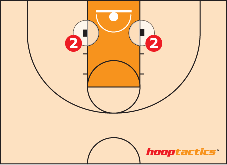
BlockThe block is a buffer area painted on the lane lines separating offensive and defensive players during a free throw attempt. Additionally, it is a very strategic area during the game. Any player - offensive or defensive - establishing a position on the block gains a definite advantage.
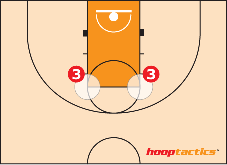
ElbowThe elbow is the area of the court where the free throw line meets the lane line. Like the "Block", the Elbows become important on dribble penetration. Any player - offense or defense - who gets to the elbow first will gain an advantage.
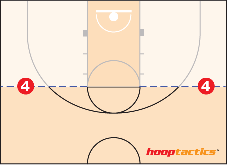
Free Throw Line Extended
This imaginary line represents the extension of the free throw line across the width of the court. Most coaches use it to establish defensive rules. When the ball is above the free throw line extended a certain rule applies. When the ball is below it another rule applies. It is also used as a reference for offensive player alignment.
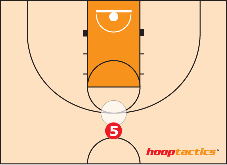
Top Of Circle (Key)The top of circle is the area straight out from the basket just outside the free throw circle. It is use primarily as a reference for aligning offensive and defensive players. It is also a favorite spot from which many players like to shoot.
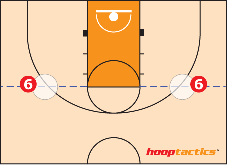
WingThe wing area is located on the side of the court near the free throw line extended. Wing areas are designated "Ballside" or Weakside" according to the location of the player with the ball. The wing on the same side as the ball handler is the "Ballside or Strongside" wing. The wing on the side away from the ball handler is the "Weakside" wing.
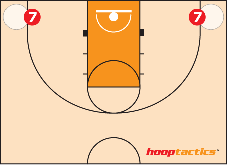
CornerThe "Corner" is primarily used to designate the area where the sideline and baseline meet. This is another favorite area from which players like to shoot. It is usually an open area when zone defense is played. However, it is also an area where the defense can readily trap an offensive player with the ball.
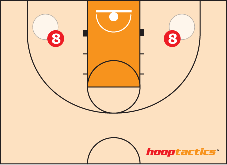
Short CornerThe short corner is an area along the baseline half way between the sideline and the lane line. It is a strategic offensive area especially used against zone defenses.

4' Restricted Area
In professional basketball there is a semi-circular 4' restraining area in front of the basket. No offensive charges can be taken by defenders when they are positioned on or inside this area.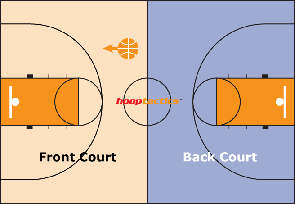
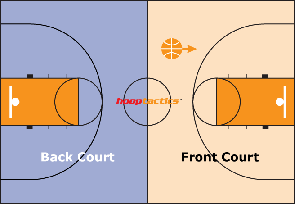
Front Court: The term Front Court is used to denote the offensive end of the court from the midcourt line to the baseline.
Back Court : Back Court is used to denote the area behind the mid court line. It includes the half of the court from the midcourt line back to the endline. Once the ball is advanced across the midcourt line into the front court, it cannot go back into the Back Court.

 Court DimensionsHigh SchoolCollege MenCollege WomenInternationalNBAWNBACourt Length85'94'94'
Court DimensionsHigh SchoolCollege MenCollege WomenInternationalNBAWNBACourt Length85'94'94'28m
(91'10")94'94'Court Width50'50'50'15m
(49'2.5")50'50'Lane Width12'12'12'4.9m
(16')16'12'Three Point Line19'9"19'9"19'9"6.25m
(20'6.1")23'9"19'9"Period Time (Number of Periods)8min
(4)20min
(2)10min
(4)10min
(4)12min
(4)10min
(4)Shot Clock30 seconds (Girls)30 seconds30 seconds
24 seconds24 seconds30 seconds
Learn more: Basketball Basics' Main Menu - Click Here
© 2024 HoopTactics All Rights Reserved.
